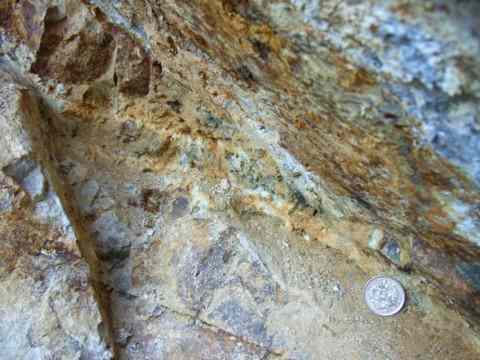Takatori Mine
Suzugoya, Shirosato city, Higashi-ibaraki county, Ibaraki pref., Japan
Occurrence
Sn-W Pneumatolytic deposit formed by intrusion of the early Paleocene (65 Ma) Inada Granite in the Late Jurassic (150 Ma) Takatori Unit of an accretionary complex, the Yamizo Group. 4 stages of the deposit formation process were recognized: 1. Greisen (Topaz + Fluorite), 2. Ferberite + Quartz, 3. Sulfide + Quartz, and 4. Pyrite + Quartz. The Takatori Unit probably corresponds to the Kamiaso Unit of the Tamba-Mino-Ashio accretionary complex. The Inada Granite is S-type (Ilmenite-series) and supplies W and F to the deposit. Ages of chert and siliceous shale in the Takatori Unit is Middle Triassic to Early Jurassic and Middle Jurassic, respectively. Approximately 10 km apart from the Inada granite, the heat source. Ages of sedimentary rocks were determined by radiolarians, and granite by K-Ar radiometric dating.

Outcrop of siliceous shale of the Takatori Unit associated with pneumatolytic deposit. The white veins around the coin are composed of fluorite, muscovite and quartz. The host is siliceous shale.
Reported Minerals
- Bismuth
- Bismuthinite
- Arsenopyrite
- Fluorite
- Topaz
- Rhodochrosite
- Apatite
- Malachite
- Cassiterite
- Ferberite
- Quartz
Mineral Assemblages
- Quartz - Muscovite - Topaz - Fluorite - Apatite
- Quartz - Muscovite - Cassiterite
- Quartz - Ferberite
History
- around 1590: Cassiterite was discovered as a placer deposit, and cassiterite was mined.
- 1908: Sojiro Ikeda and Mankichi Kanazawa discovered an outcrop of wulframite deposit, and started to mine W.
- 1921: The mine was closed.
- 1925: Restart to mine.
- 1930: The mine was closed.
- 1944: Restart to mine.
- 1963: The mine was closed.
- 1967: Restart to mine.
- 1985: The mine was closed.
Locality
- Takatori Mine (Ferberite)
- Ebisu Mine (Wolframite)
- Togane Mine (Wolframite)
- Komaki Mine (Wolframite)
- Itaga Mine (Andalusite)
- Otani Mine (Cassiterite, Scheelite)
- Taisho Mine (Cassiterite)
- Ichiyanagi Mine (Löllingite)
- Takane Mine (Bismuth)
- Karasawa Mine (Bismuth)
- Takemori (Dravite)